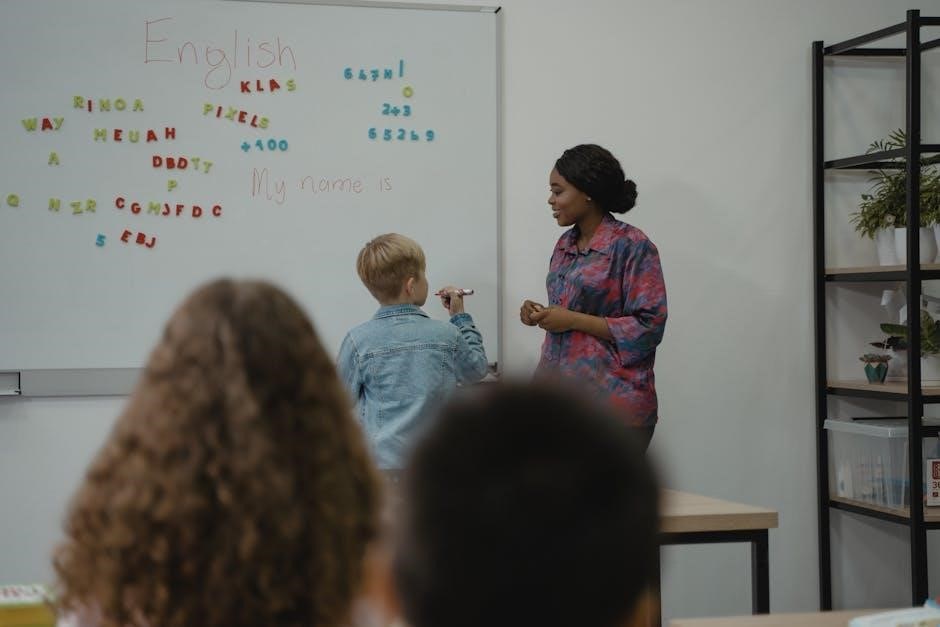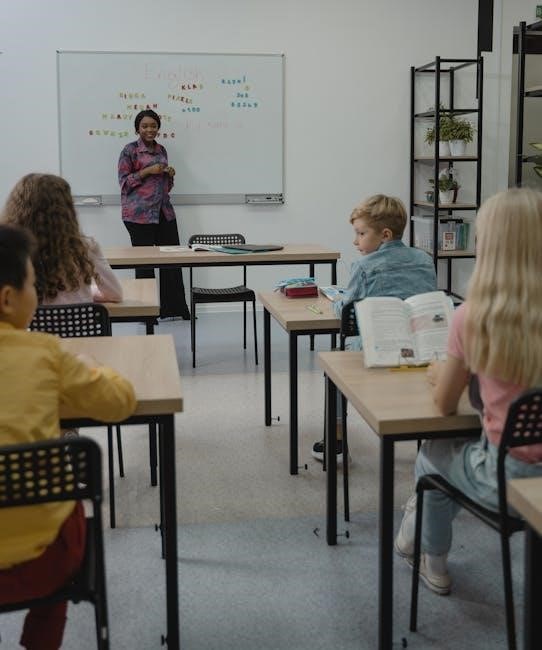
english language learners lesson plans pdf
ELL lesson plans are structured to support non-native English speakers‚ focusing on vocabulary‚ grammar‚ and cultural integration. They provide a comprehensive framework for language development‚ ensuring accessibility and engagement for diverse learners.
These plans often include PDF formats‚ offering teachers customizable tools to cater to varying proficiency levels. They emphasize interactive activities‚ reading‚ writing‚ and speaking exercises tailored to meet ELL students’ unique needs.
By incorporating thematic instruction and multimedia resources‚ ELL lesson plans create an inclusive learning environment. They aim to bridge language gaps‚ fostering academic success and cultural understanding for students of all backgrounds.
1.1. Overview of ELL Education
English Language Learner (ELL) education focuses on supporting students who are non-native English speakers. It emphasizes language development‚ cultural adaptation‚ and academic integration. ELL programs aim to bridge language gaps‚ ensuring students access core curriculum while building proficiency in reading‚ writing‚ speaking‚ and listening.
Lesson plans are tailored to meet diverse needs‚ incorporating visual‚ auditory‚ and kinesthetic learning strategies. They often include thematic instruction‚ vocabulary building‚ and grammar exercises. ELL education also integrates cultural awareness‚ fostering an inclusive classroom environment.
Resources like PDF lesson plans provide structured frameworks for teachers‚ promoting consistency and accessibility. These tools help educators create engaging‚ effective instruction for ELL students‚ supporting their linguistic and academic growth.
1.2. Importance of Structured Lesson Plans for ELL Students
Structured lesson plans are crucial for ELL students‚ providing clarity and consistency in language learning. They ensure teachers address specific skills‚ such as vocabulary‚ grammar‚ and pronunciation‚ in a logical sequence.
These plans help scaffold instruction‚ breaking tasks into manageable steps to prevent overwhelm. They also promote cultural relevance‚ making content relatable and engaging for diverse learners.
Structured plans enable differentiation‚ catering to varying proficiency levels and learning styles. They include measurable objectives‚ allowing teachers to track progress and adjust instruction effectively.
1;3. Benefits of Using PDF Formats for Lesson Plans
Using PDF formats for ELL lesson plans offers numerous advantages. PDFs are easily accessible‚ printable‚ and maintain consistent formatting across devices‚ ensuring clarity and readability.
They allow teachers to customize and share resources efficiently‚ providing a universal format that works for all. PDF lesson plans often include interactive elements like worksheets and activities‚ making them versatile tools for classroom use.
Additionally‚ PDFs are ideal for archiving and future reference‚ enabling teachers to build a library of reusable materials. This format supports quick dissemination and ensures that ELL students receive high-quality‚ structured learning resources.

Foundational Skills for English Language Learners
Foundational skills for ELLs include basic vocabulary‚ grammar‚ pronunciation‚ and listening/speaking abilities. These skills are developed through interactive activities‚ ensuring a strong base for further language learning.
2.1. Basic Vocabulary Development Strategies
Basic vocabulary development strategies for ELLs involve engaging activities to introduce and reinforce new words. Flashcards‚ word games‚ and contextual exercises are effective tools for building foundational language skills.
Interactive activities‚ such as matching games and word associations‚ encourage active participation. Repetition and real-life applications help students connect words to meanings‚ fostering retention and practical usage in everyday situations.
2.2. Grammar Fundamentals for Beginners
Grammar fundamentals for ELL beginners focus on introducing basic sentence structures and rules. Lesson plans often start with simple verb forms‚ nouns‚ and pronouns to build a strong foundation.
Interactive exercises‚ such as fill-in-the-blank activities and sentence building‚ help students grasp concepts like subject-verb agreement and word order. Visual aids and hands-on tasks make learning engaging and accessible.
2.3. Pronunciation Practice Activities
Pronunciation practice activities are essential for ELL students to develop clear and accurate speech. Lesson plans often include listening exercises‚ where students repeat phrases and focus on intonation‚ stress‚ and rhythm.
Interactive tools like audio clips and videos provide models for correct pronunciation. Activities such as role-playing‚ pair work‚ and group discussions encourage students to apply their skills in real-life contexts.
These exercises help students overcome common challenges‚ such as difficulty with specific sounds or syllable stress‚ fostering confidence in their ability to communicate effectively in English.
2.4. Listening and Speaking Exercises
Listening and speaking exercises are crucial for ELL students to build confidence in real-life communication. Activities include role-playing‚ pair work‚ and group discussions to simulate everyday conversations.
Audio and video resources provide authentic listening materials‚ while guided speaking tasks focus on clear pronunciation and grammar. These exercises help students understand different accents and improve their ability to respond appropriately in various contexts.
Regular feedback and encouragement enable learners to refine their skills‚ fostering fluency and accuracy in both listening and speaking.

Reading and Writing Skills for ELL Students
Reading and writing skills are foundational for ELL students‚ focusing on phonics‚ vocabulary‚ and comprehension. Structured activities guide learners from basic decoding to fluent‚ expressive writing.
3.1. Phonics and Decoding Techniques
Phonics and decoding are essential for ELL students to master reading skills. Lesson plans incorporate systematic phonics instruction‚ focusing on sound-letter relationships‚ word patterns‚ and blending sounds into words.
Activities include identifying rhymes‚ segmenting words‚ and recognizing syllables. Decoding techniques involve guided practice with texts‚ emphasizing fluency and accuracy. Visual aids like charts and flashcards support learning.
Interactive games and exercises reinforce phonics skills‚ making lessons engaging. These strategies help ELL students build a strong foundation for reading comprehension and overall language proficiency. PDF resources often include worksheets and activities tailored for this purpose.
3.2. Reading Comprehension Strategies
Reading comprehension strategies are vital for ELL students to understand and interpret texts effectively. Lesson plans often include pre-reading activities‚ such as previewing vocabulary and discussing themes‚ to build background knowledge.
Guided reading sessions and think-aloud techniques help students identify main ideas‚ make inferences‚ and ask questions. Visual aids like graphic organizers and summaries enhance understanding.
Interactive exercises‚ such as group discussions and reading aloud‚ promote engagement. PDF resources provide structured worksheets and comprehension tasks tailored for ELL students‚ ensuring they grasp both literal and inferential meanings.
3.3. Creative Writing Activities

Creative writing activities for ELL students foster imagination and language development through engaging exercises like storytelling‚ journaling‚ and poetry. Lesson plans often include brainstorming sessions to generate ideas‚ followed by guided writing prompts tailored to students’ proficiency levels.
Activities such as writing short paragraphs or dialogues encourage students to apply grammar and vocabulary creatively. Collaborative projects‚ like group stories or role-playing‚ enhance communication skills and cultural expression. PDF resources provide structured templates and examples to support learners in organizing their thoughts and expressing themselves confidently.
3.4. Sentence Structure and Composition
Sentence structure and composition lessons for ELL students focus on building clear and grammatically correct sentences. Activities include sentence building exercises‚ fill-in-the-blank worksheets‚ and sentence combining tasks to reinforce grammar rules.
Lesson plans often incorporate scaffolding techniques‚ such as visual aids and sentence frames‚ to help students organize ideas logically. Guided practice with sentence starters and transition words enhances coherence and fluency. PDF resources provide structured worksheets and examples‚ enabling students to practice independently and confidently.

Vocabulary Development Lesson Plans
Vocabulary development lesson plans for ELLs include thematic instruction‚ flashcard activities‚ and contextual learning. PDF formats offer clear‚ reusable materials for teachers and students.
4.1. Thematic Vocabulary Instruction
Thematic vocabulary instruction organizes learning around topics like food‚ transportation‚ or holidays. This approach enhances retention by linking words to meaningful contexts‚ making them easier to remember.
- Uses flashcards and games to introduce related terms.
- Incorporates real-life scenarios and cultural references.
- Includes activities like word associations and memory techniques.
PDF lesson plans provide structured‚ reusable materials for teachers‚ ensuring vocabulary is taught cohesively and engagingly‚ catering to diverse learning styles and proficiency levels.
4.2. Using Flashcards and Games for Vocabulary
Flashcards and games are interactive tools that make vocabulary learning engaging for ELL students. Flashcards can be used for quick word recognition‚ while games like charades or bingo encourage active participation and repetition.
- Games promote friendly competition‚ motivating students to practice and retain new words.
- Flashcards can be paired with images or sentences for contextual learning.
- These activities reduce language learning anxiety‚ fostering a relaxed classroom environment.
PDF lesson plans often include printable flashcards and game instructions‚ providing teachers with ready-to-use materials to enhance vocabulary acquisition in a fun and dynamic way.
4.3. Contextual Learning Activities
Contextual learning activities immerse ELL students in real-life scenarios‚ making vocabulary acquisition meaningful and relatable. These activities‚ often included in PDF lesson plans‚ use visual aids‚ role-playing‚ and group tasks to teach words in context.
- Students engage in conversations or problem-solving activities that mirror real-world interactions.
- Visual aids like pictures or videos help students connect words with meanings.
- Group tasks encourage collaboration‚ reinforcing language retention through practical use.
Contextual learning enhances comprehension and application‚ ensuring students can use new vocabulary in authentic situations‚ both in and out of the classroom.
4.4. Word Association and Memory Techniques
Word association and memory techniques are powerful tools for ELL students to retain vocabulary. These methods‚ often detailed in PDF lesson plans‚ help learners create mental connections between words and meanings.
- Word association games encourage students to link new vocabulary to familiar terms or concepts.
- Memory aids like mnemonics or visual cues enhance retention and recall.
- Group activities‚ such as brainstorming sessions‚ promote collaborative learning and reinforce word meanings.
These techniques make vocabulary acquisition engaging and effective‚ helping ELL students build a stronger foundation in English.

Grammar and Sentence Structure
Grammar and sentence structure form the foundation of clear communication for ELL students. Lesson plans often include exercises on verb tenses‚ sentence formation‚ and proper word order.
Activities focus on building confidence in creating grammatically correct sentences‚ enabling students to express ideas effectively in both spoken and written English.
5.1. Basic Sentence Formation Rules
Basic sentence formation rules are essential for ELL students to communicate effectively. Lesson plans often start with simple subject-verb structures‚ ensuring clarity and correctness in sentence construction.
Activities focus on identifying and arranging words logically‚ emphasizing proper word order and punctuation. Students practice forming sentences using flashcards and worksheets‚ gradually progressing to more complex structures.
These exercises build confidence and provide a solid foundation for expressing ideas clearly. Interactive games and group activities reinforce learning‚ making grammar accessible and engaging for all proficiency levels.
5.2. Tenses and Verb Usage
Understanding tenses and verb usage is crucial for ELL students to communicate effectively. Lesson plans introduce present‚ past‚ and future tenses through clear examples and exercises.
Activities focus on identifying and using verbs correctly in sentences‚ with visual aids like timelines to reinforce concepts. Students engage in pair work‚ role-playing‚ and verb conjugation drills to build proficiency.
Practical exercises‚ such as filling in the blanks and creating short dialogues‚ help students apply tenses in real-life contexts. Teachers provide feedback to ensure accurate usage‚ fostering confidence in verbal communication.
5.3. Nouns‚ Pronouns‚ and Prepositions
ELL lesson plans emphasize mastering nouns‚ pronouns‚ and prepositions to build strong sentence structures. Activities include matching games‚ fill-in-the-blank exercises‚ and role-playing to practice usage in context.
Students learn to identify and use personal‚ possessive‚ and reflexive pronouns‚ along with common prepositions like “in‚” “on‚” and “at.” Interactive exercises‚ such as labeling diagrams and creating short sentences‚ reinforce understanding.
Visual aids like charts and flashcards help students visualize relationships between words‚ while group work encourages collaborative learning and immediate feedback from teachers.
5.4; Adjectives and Adverbs in Context
ELL lesson plans incorporate activities to teach adjectives and adverbs‚ focusing on their usage in sentences. Students engage in matching games‚ where they pair adjectives with nouns and adverbs with verbs‚ reinforcing grammatical context.
Exercises include fill-in-the-blank sentences‚ identifying correct forms‚ and creating short stories. Visual aids like word charts and videos help students visualize how adjectives modify nouns and adverbs modify verbs‚ adjectives‚ or other adverbs.
Group discussions and role-playing activities encourage practical application‚ while worksheets provide structured practice. These methods help ELL students understand the nuances of adjectives and adverbs‚ enhancing their ability to express complexity in English.

Cultural Integration in ELL Lessons
Cultural integration in ELL lessons involves activities that promote cross-cultural awareness‚ using multimedia to expose students to diverse traditions and practices‚ fostering inclusive communication and mutual understanding.
6.1. Cultural Awareness Activities
Cultural awareness activities in ELL lessons help students explore and appreciate diverse traditions‚ fostering empathy and understanding. These activities often include group discussions‚ multimedia presentations‚ and interactive exercises.
Students engage in sharing personal cultural practices‚ such as holidays‚ food‚ and music‚ promoting cross-cultural communication. Teachers use visual aids and real-life examples to make lessons relatable and inclusive for all learners.
Such activities not only enhance language skills but also encourage students to value their own and others’ cultural backgrounds‚ creating a harmonious and respectful classroom environment tailored to ELL needs.
6.2. Incorporating Cultural Context in Lessons
Incorporating cultural context into ELL lessons enhances language acquisition by connecting it to real-life scenarios and diverse traditions. Teachers use authentic materials like stories‚ images‚ and music to illustrate cultural nuances‚ making lessons more engaging and relatable.
By integrating cultural elements‚ lessons become more inclusive‚ allowing students to see reflections of their own backgrounds while exploring others. This approach fosters a deeper understanding of language usage within specific cultural frameworks‚ ensuring ELL students feel valued and motivated in their learning journey.
6;3. Using Multimedia for Cultural Exposure
Multimedia tools like videos‚ audio clips‚ and interactive content enhance cultural exposure for ELL students. These resources provide authentic cultural insights‚ making lessons engaging and relatable.
Teachers can incorporate multimedia to showcase traditions‚ festivals‚ and daily life from diverse cultures. This fosters cross-cultural understanding and helps students connect language learning to real-world contexts‚ enriching their educational experience.
6.4. Encouraging Cross-Cultural Communication
Encouraging cross-cultural communication helps ELL students connect with peers from diverse backgrounds‚ fostering mutual understanding and respect. Group discussions‚ role-playing‚ and collaborative activities enable students to share cultural practices and traditions.
Teachers can use multimedia resources‚ such as videos and audio clips‚ to expose students to different cultural perspectives. Pairwork activities‚ like asking about birthdays or holidays‚ promote meaningful interactions and language practice.
These strategies not only enhance language skills but also break down stereotypes‚ creating an inclusive classroom environment where cultural diversity is celebrated and valued.

Differentiated Instruction for ELLs
Differentiated instruction tailors learning to meet ELLs’ varied needs‚ using scaffolding techniques‚ tiered assignments‚ and technology tools to ensure personalized and effective language acquisition.
7.1. Learning Style-Based Activities
Learning style-based activities cater to individual preferences‚ enhancing engagement for ELL students. Visual learners benefit from charts and images‚ while auditory learners thrive with discussions and audio resources.
Kinesthetic learners engage through hands-on tasks like role-playing and interactive games. Incorporating diverse methods ensures all students can access content effectively‚ fostering a personalized learning environment that supports language acquisition.
7.2. Tiered Assignments for Varied Proficiency
Tiered assignments cater to ELL students’ diverse proficiency levels by adjusting task complexity and language demands. This approach ensures all learners engage meaningfully‚ regardless of their skill level.
Beginners might focus on simplified vocabulary and sentence structures‚ while advanced learners tackle more complex texts or discussions. This differentiation promotes equitable learning opportunities and supports individual progress.
Teachers can incorporate scaffolding techniques‚ such as visual aids or sentence frames‚ to aid comprehension. Tiered assignments also encourage peer support‚ fostering a collaborative classroom environment that values diverse abilities.
7.3; Technology Integration for Personalized Learning
Technology integration enhances ELL learning by providing personalized resources tailored to individual needs. Digital tools‚ such as language-learning apps and interactive websites‚ offer engaging activities that cater to diverse proficiency levels.
Multi-media resources‚ including videos and audio files‚ help students practice pronunciation and listening skills. Additionally‚ online platforms allow teachers to assign self-paced exercises‚ ensuring learners can progress at their own speed.
Technology also facilitates real-time feedback and progress tracking‚ enabling teachers to adapt instruction dynamically. This approach not only boosts language acquisition but also makes learning more interactive and relevant for ELL students.
7.4. Scaffolding Techniques for Complex Tasks
Scaffolding techniques break complex tasks into manageable steps‚ providing temporary support as ELL students build language and academic skills; Teachers use models‚ visual aids‚ and guided practice to help learners understand and execute challenging assignments.
These techniques include sentence frames‚ graphic organizers‚ and gradual release of responsibility. By offering structured guidance‚ scaffolding enables students to develop confidence and independence in completing tasks‚ fostering a deeper understanding of the material.
This approach ensures that learners are not overwhelmed‚ allowing them to focus on specific skills within their proficiency level and gradually master more complex tasks.

Assessment and Feedback Strategies
Effective assessments and feedback strategies are crucial for ELL students‚ helping track progress and guide improvement in language skills. Formative assessments identify strengths and areas for growth‚ while summative evaluations measure overall proficiency. Constructive feedback‚ both verbal and written‚ encourages learners to refine their skills. Peer and self-assessment activities foster reflection and accountability‚ empowering students to take ownership of their learning. These strategies ensure personalized support‚ enabling ELLs to achieve their language goals confidently and effectively.
8.1. Formative Assessment Tools
Formative assessments are essential for monitoring ELL students’ progress and understanding during lessons. Tools like quizzes‚ class discussions‚ and interactive activities provide immediate feedback‚ helping teachers identify learning gaps. Digital platforms and worksheets are widely used to track vocabulary and grammar development. Exit tickets and quick write-ups allow teachers to gauge comprehension quickly. These tools enable educators to adjust instruction‚ ensuring students receive targeted support. By incorporating formative assessments‚ teachers can differentiate instruction‚ engage learners‚ and foster a growth-oriented classroom environment tailored to ELL needs.
8.2. Summative Assessment Methods
Summative assessments evaluate ELL students’ language proficiency at the end of a lesson or unit. Tools include written tests‚ oral presentations‚ and project submissions‚ providing a comprehensive understanding of their progress. Standardized tests and rubrics ensure fairness‚ while portfolios and group projects offer a holistic view; These assessments help determine mastery of skills and readiness for advanced content. Teachers use summative results to report progress‚ adjust curricula‚ and celebrate achievements‚ ensuring ELL students meet language and academic goals effectively.
8.3. Providing Constructive Feedback
Constructive feedback is essential for ELL students’ growth‚ helping them understand strengths and areas for improvement. Teachers should provide specific‚ actionable comments tied to learning objectives‚ balancing positive reinforcement with targeted suggestions. For example‚ highlighting correct vocabulary usage while gently correcting grammar errors. Feedback should be clear‚ culturally sensitive‚ and delivered in a supportive manner to build confidence. Incorporating examples from student work and breaking complex feedback into smaller‚ manageable parts can enhance understanding. Encouraging self-assessment and peer feedback fosters a collaborative learning environment‚ empowering students to take ownership of their language development and progress.
8.4. Peer and Self-Assessment Activities
Peer and self-assessment activities empower ELL students to take ownership of their learning. These activities include peer reviews of written work‚ role-playing exercises‚ and group discussions where students provide feedback. Self-assessment tools‚ such as reflection journals or checklists‚ help students evaluate their own progress. Teachers can guide students by modeling constructive feedback and providing clear criteria for evaluation. Peer interactions foster collaboration and reduce anxiety‚ as students learn from one another. These activities also encourage critical thinking and self-awareness‚ enabling students to identify areas for improvement and set achievable goals. Regular practice builds confidence and enhances overall language proficiency in a supportive environment.

Additional Resources for ELL Teachers
ELL teachers can access printable PDF worksheets‚ online forums‚ and recommended textbooks for lesson planning. Supplementary materials‚ like flashcards and multimedia tools‚ further enhance teaching strategies and student engagement.
9.1. Printable PDF Worksheets and Templates
Printable PDF worksheets and templates are invaluable resources for ELL teachers‚ offering structured activities for vocabulary‚ grammar‚ and reading comprehension. These materials are customizable to suit varying proficiency levels‚ ensuring tailored support for each student. Teachers can use PDF templates for creating flashcards‚ word searches‚ and crossword puzzles‚ making learning engaging and interactive. Many resources include answer keys and teaching notes‚ simplifying lesson preparation. Additionally‚ PDF worksheets are easily shared and reused‚ supporting differentiated instruction and scaffolding activities. They provide a practical and accessible way to reinforce language skills‚ catering to diverse learning needs and styles.
9.2. Online Communities and Forums for ELL Educators
Online communities and forums provide ELL educators with a collaborative space to share resources‚ discuss challenges‚ and exchange best practices. Platforms like TESOL International Association and ESL forums offer access to lesson plans‚ research‚ and professional development opportunities. These communities enable teachers to connect globally‚ gaining insights into diverse teaching strategies and cultural perspectives. Many forums also feature discussions on PDF lesson plans‚ offering educators a wealth of downloadable materials tailored to ELL needs. By engaging in these networks‚ teachers can refine their approaches‚ receive feedback‚ and stay updated on innovative methods for supporting language learners.
9.3. Recommended Textbooks and Guides
Recommended textbooks and guides for ELL educators provide comprehensive strategies and practical tools for teaching English language learners. Titles like The ESL/ELL Teacher’s Survival Guide by Larry Ferlazzo and English Learners‚ Academic Literacy by Aida Walqui offer evidence-based methods for lesson planning and language development. Publishers like Oxford University Press and Cambridge University Press specialize in ELL resources‚ offering textbooks that align with curriculum standards. These guides often include sample lesson plans‚ activity ideas‚ and assessments to support diverse learning needs. Digital companions and supplementary materials further enhance their utility‚ making them indispensable for ELL educators seeking to create engaging and effective instruction.
9.4. Supplementary Materials for Lesson Planning
Supplementary materials for ELL lesson planning include worksheets‚ activity templates‚ and multimedia resources that enrich instruction. Printable PDF worksheets focus on vocabulary‚ grammar‚ and reading skills‚ while games and puzzles make learning interactive. Online forums and educator communities provide access to shared resources and innovative ideas. Multimedia tools‚ such as audio clips and videos‚ enhance cultural exposure and engagement. These materials are designed to support differentiated instruction and cater to varied learning styles. By incorporating these resources‚ teachers can create dynamic and inclusive lesson plans that meet the diverse needs of English language learners and promote academic success.